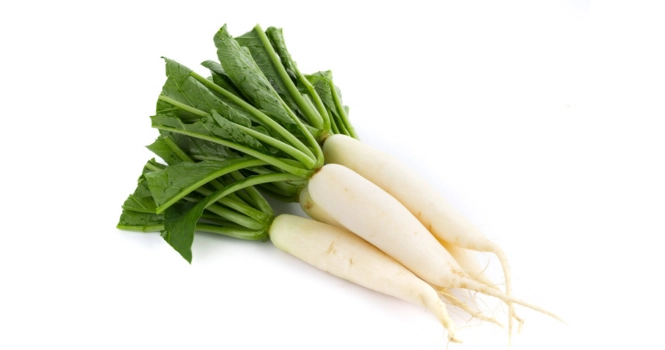Why Do We Eat Radishes?

Radishes are edible root vegetables known for their crisp texture and peppery flavor. Scientifically named “Raphanus sativus,” they belong to the Brassicaceae family, alongside mustard and cabbage.
Originating in Southeast Asia, radishes come in various shapes, sizes, and colors, including red, white, purple, and black.
They are a nutrient-rich food, low in calories but high in vitamin C, fiber, and antioxidants.
Commonly used in salads, they can also be cooked or pickled. Beyond their culinary uses, radishes offer health benefits like aiding digestion, supporting immune function, and contributing to cardiovascular health.
Radish Scientific Name
The scientific name for the radish is “Raphanus sativus.”
Radish Family
Radishes belong to the Brassicaceae family, the same family as broccoli, cabbage, and mustard.
Radish Origin
Radishes originated in Southeast Asia and have been cultivated for thousands of years.
Radish Chromosome Number
Radishes have 18 chromosomes.
Why Do We Eat Radishes? Radish Benefits
Radishes are not only a crunchy, peppery addition to salads and dishes but also pack a variety of health benefits that make them a valuable part of our diet:
1. Nutrient-Rich: Radishes are a good source of vitamin C, which is crucial for immune function and skin health. They also contain small amounts of other vitamins and minerals, including potassium and folate.
2. Digestive Health: High in fiber, radishes can help maintain a healthy digestive system. Fiber aids in bowel regularity and helps prevent constipation. It also contributes to gut health by feeding beneficial gut bacteria.
3. Low in Calories, High in Water: Radishes are low in calories, making them an excellent choice for weight management. Their high water content helps keep you hydrated and can contribute to a feeling of fullness, potentially reducing overall calorie intake.
4. Antioxidant Properties: Radishes contain compounds like sulforaphane, found in cruciferous vegetables, which may have anti-cancer properties. They also have other antioxidants that help combat damage from free radicals.
5. Blood Pressure Management: The potassium in radishes can help manage blood pressure by balancing out the negative effects of sodium.
6. Skin Health: Vitamin C, zinc, and phosphorus in radishes can promote skin health and the healing of skin conditions when consumed as part of a balanced diet.
7. Immune System Support: The vitamin C in radishes is essential for boosting the immune system and healing wounds.
8. Anti-Inflammatory Effects: Some compounds in radishes have anti-inflammatory properties, which can benefit people with inflammatory conditions.
9. Improves Cardiovascular Health: Radishes contain anthocyanins, a type of flavonoid which not only gives them their color but also contributes to heart health. Anthocyanins are linked with reduced incidence of cardiovascular disease.
10. Blood Sugar Control: Despite their sweet taste, radishes have a low glycemic index, which means they do not cause a significant spike in blood sugar levels.
They are versatile, can be eaten raw or cooked, and add a unique flavor and crunch to a variety of dishes.
Frequently Asked Questions
Can we drink radish juice daily?
Yes, in moderation. Radish juice can be healthy, but it’s best to vary your diet.
What is the importance of Radish chromosome number?
The chromosome number of a plant, including the radish (Raphanus sativus), which has 18 chromosomes (9 pairs), is significant for several reasons in the fields of botany, genetics, and plant breeding:
1. Genetic Diversity and Breeding: The chromosome number is crucial for plant breeders. Knowing the specific chromosome number helps in crossbreeding programs. For instance, when breeders want to introduce traits from one species to another, compatible chromosome numbers can make this process more feasible.
2. Species Classification: Chromosome number can aid in classifying species and understanding their evolutionary relationships. Closely related species often have similar chromosome numbers, which helps in studying plant evolution and taxonomy.
3. Genetic Stability and Variation: The number of chromosomes is linked to genetic stability and variation within a species. Changes in chromosome number (due to mutations, for example) can lead to significant variations in a plant’s characteristics, which can be both a challenge and an opportunity for breeders.
4. Polyploidy: Some plants can have multiple sets of chromosomes (polyploidy), which can result in larger, more robust plants. Understanding the natural chromosome number is essential when creating polyploid variants, which is a common practice in agricultural biotechnology to enhance certain plant traits.
5. Studying Plant Mechanisms: The chromosome number also provides insights into the mechanisms of plant growth, development, and reproduction. Researchers can study how different genes located on these chromosomes contribute to the plant’s characteristics.
6. Conservation and Preservation: Knowing the chromosome number is important for conservation biology. It helps in understanding the genetic makeup of species and in planning strategies for preserving genetic diversity.
The chromosome number of radishes (and other plants) is significant for understanding their genetics, aiding in plant breeding and conservation efforts, and providing insights into their evolutionary biology.
![]()












